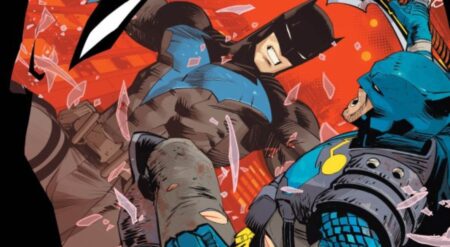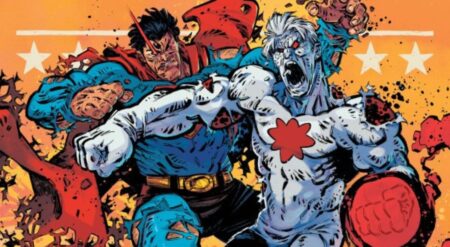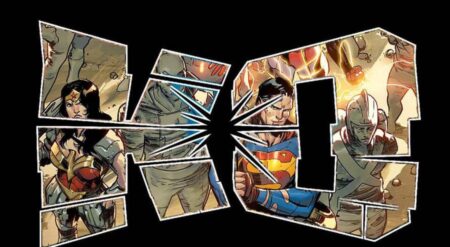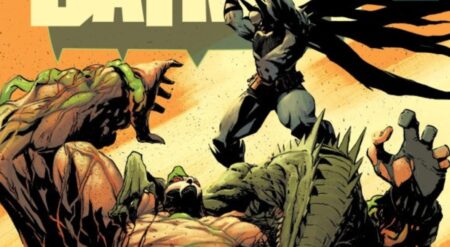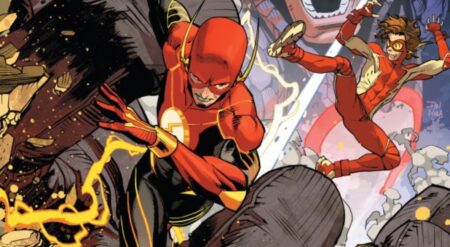
With the relaunch of Vertigo with it’s 25th anniversary, Neil Gaiman’s world of the Dreaming from his work on Sandman is expanding. Lucifer Vol 1: The Infernal Comedy is one of four books curated by Gaiman for DC Vertigo which expand his existing world under the banner of The Sandman Universe.
As one of four ongoing series, Gaiman is evolving and weaving together a larger space for fantasy. In Lucifer Vol. 1, the onetime ruler of Hell is missing, finding himself imprisoned and crippled by mysterious forces who only have his torture in mind. With memories gone, we watch as Lucifer moves through a hell where he is powerless and a man named John Decker moves on the outside, pulled to Lucifer’s world.
The creative team behind Lucifer Vol 1: The Infernal Comedy is large with writing credits for Dan Watters, Neil Gaiman, Simon Spurrier, Kat Howard, and Nalo Hopkinson, letters by Steve Wands and Simon Bowland, colors by Dave McCaig and Mat Lopes, and art credits for Max and Sebastian Fiumara, Bilquis Evely, Tom Fowler, and Dominike Stanton.
The story in Lucifer Vol. 1 is anything but linear, something that is eased by reading it in a collected volume instead of each of the issues, one through six, individually. Jumping from the Dreaming, to Lucifer, to John Decker dealing with his wife Penelope’s illness, to the Lucifer in his prison, to Lucifer and his son Caliban, to Decker grieving his wife, to Lucifer digging for freedom, to Decker seemingly falling victim to same illness as his wife, and so on. It’s easy to lose your place.
With that said, the lettering team does a consistent and dynamic job of crafting unique styles for each character’s dialogue, inner thoughts, and narrative. This allows the designs to degrade with the characters’ sense of self. The style accents the writing of this issue which is raw and beautiful, and ultimately written in multiple voices that lend to an immersive story.
The art is gorgeous for multiple reasons. It is horrific when it needs to be, showing Lucifer Morningstar’s violence in a beautiful a terrifying light that is also completely gorgeous, with the pain in the background of the Lucifer’s Bowie-esque beauty. In his prison, Lucifer isn’t alone. The land he is in is filled with those he deceived into deals with him. We see amazing renditions of William Blake, the Fates, and more, with their stories from legend retold in Lucifer Vol. 1. But, as Lucifer don’t remember, neither do they. As they each come into the story we see their stories played out in violence and deceit. Not only told with a mix of narrative and dialogue but stunningly illustrated.
The other moments of stunning art are those that showcase Decker discovering the world that Lucifer moves through while simultaneously depicting his growing illness, but leaving the door open to question: Is this his health or is this Lucifer and his world’s doing? In one section we the depiction of seizures, which I never thought could be drawn in such a visceral and authentic way. Yet, in another, we see the appearance of demons, replacing the images of humans.
While we understand that there is a thin line between the two as the audience, the narration and consistent changes in places in the story confuses us along with Decker, before pulling all of the threads together in the ending, leaving with a path forward for both Decker and the Devil.
One of the more stunning images of Lucifer Vol. 1 is the depiction of Decker receiving contact from Lucifer’s prison. When we learn that Decker has a tumor, the red mass calling him to the hidden house is both a call from a world beyond but also a depiction of the mass in his brain, the mass that was in wife’s brain.
There are many things to love about Lucifer Vol. 1, however, the first issue is heavily centered around the Dreaming, before connecting to Lucifer’s story. While I understand the need, I can’t help but think that that first issue could have been compacted, allowing pages in later issues to go deeper into Decker. While Decker’s seizures begin to cause jumps in his time, his inclusion in this story could be expanded, and Penelope’s connection and the magic behind his growing illness could have been unpacked and given more impact.
In addition, it may also be a little hard to understand in the beginning if you are unfamiliar with Gaiman’s world of Sandman Universe. The first issue of the volume may catch you off guard and since it just jumps into the universe it will leave a new reader wondering about some of the mechanics of the Dreaming.
Overall Lucifer is a series that benefits from being read in volume form. The story becomes easier to follow and the pacing is great enhanced. Since the beauty of the book is also one of the better parts, the inclusion of variant colors and character sketches are the perfect addition to any fan. Lucifer Vol. 1: The Divine Comedy may not be a hit for all given some fairly graphic panels of violence, but if that doesn’t bother you, it’s a great read.
Lucifer Vol 1: The Infernal Comedy will be available on June 19th everywhere comics are sold.
Lucifer Vol. 1: The Infernal Comedy
TL;DR
Overall Lucifer is a series that benefits from being read in volume form. The story becomes easier to follow and the pacing is great enhanced. Since the beauty of the book is also one of the better parts, the inclusion of variant colors and character sketches are the perfect addition to any fan. Lucifer Vol. 1: The Divine Comedy may not be a hit for all given some fairly graphic panels of violence, but if that doesn’t bother you, it’s a great read.


